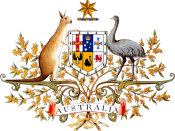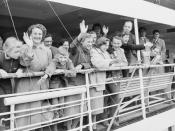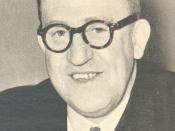Following the end of World War II, the Australian government took an entirely new approach to migration. The near invasion of Australia by the Japanese resulted in a complete rethink of ideal population numbers. As Prime Minister Ben Chifley said, 'a powerful enemy looked hungrily toward Australia...we must populate Australia as rapidly as we can before someone else decides to populate it for us'. As a result, in 1945, the Department of Immigration was established, lead by Arthur Calwell. It aimed for Australia to have an annual population growth of two per cent, of which only half could come from natural increase. 70,000 British immigrants a year were needed to make up the difference. Calwell commenced the mass migration policy with the slogan, 'Populate or Perish'.
The Australian government wanted the majority of immigrants to be British. Calwell said that 'It is my hope that for every foreign migrant there will be 10 people from the United Kingdom'.
The reason for this preference for British immigrants was that it was thought that the British culture and way of life was more similar to Australian life style. Also there would not be a language barrier between the British migrants and the Australians. It was believed that because of these reasons it would be easier for the British to assimilate into Australian society. As an incentive Calwell introduced a passage from Britain to Australia for ã10. This initiative attracted over a million British migrants.
However the British Government was both unable and unwilling to meet the high target Australia required for British migrants. At the same time, some 11 million people had survived the Nazi labour and concentration camps and many, particularly Poles, Yugoslavs, Latvians, Ukrainians and Hungarians, were unable or unwilling to return home. Following a visit to Europe in 1947,


